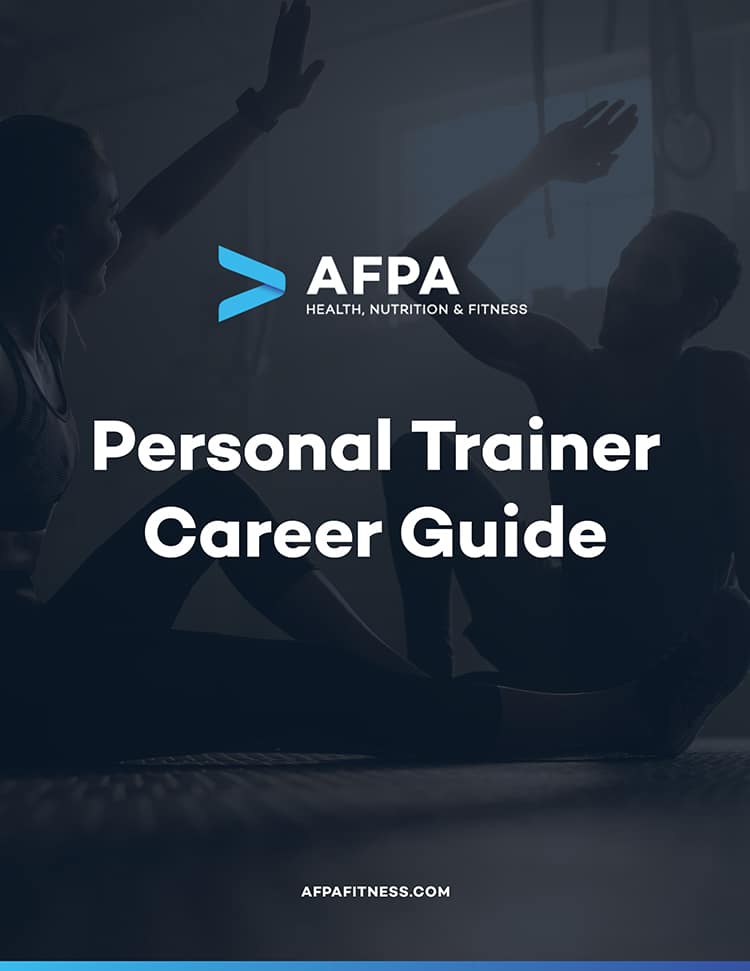High impact exercises, like interval sprints, box jumps, and burpees, can improve your clients’ cardiovascular fitness, bone mineral density, muscular strength, and athletic performance.
But there’s one problem, and it’s something you may have realized as a Certified Personal Trainer: Not all clients are suited for or enjoy high-impact exercises.
High-impact exercises can be hard on the knees, joints, and lower back. So, for clients with feet, arch (e.g., plantar fasciitis or Achilles tendinitis), or joint issues in general, high-impact workouts could potentially exacerbate those conditions—or even contribute to creating new ailments.
That’s where low-impact exercises come in. Here, we outline what constitutes a low-impact workout, its benefits, and, perhaps most importantly, how you can go about adapting any client’s routine into a joint-friendly one.
Learn How to Become a Certified Personal Trainer Online in Less Than 6 Months

What Is “Low-Impact Exercise”?
When it comes to exercise, the term “impact” refers to how much force a particular movement puts on a client’s body.
Anything that has your client taking one or both feet off the ground, then landing again, like jumping, running, or skipping, puts a high amount of stress on your client’s joints. So, in contrast to that, low-impact exercise is any movement that doesn’t subject the joints to that impact force from the ground.
Another way to think about low-impact exercises: One or both feet will always be grounded for standing exercises (e.g., split squats and glute bridges), or if your client is sitting or swimming, no impact will occur anywhere in the body.
One of the biggest misconceptions about low-impact exercise is that it’s also necessarily low-intensity. But “impact” and “intensity” are different concepts.
The latter refers to the amount of energy required for your client to perform the physical activity (i.e., how “hard” they’re working). To better illustrate the difference between the exercise impact and intensity, consider this: Your client could pedal at a vigorous pace on a stationary bike with minimal stress placed on their joints.
Meaning? Both you—and your client—don’t have to feel constrained by the low-impact factor of their workouts.
By manipulating their exercise intensity, you could help them reap the benefits of physical activity across all intensities (e.g., improved blood pressure for moderate-intensity; elevated metabolism post-workout for high-intensity).
Benefits of Low-Impact Workouts
Another misconception of low-impact workouts is that they’re “inferior” to high-impact ones. In reality, though, there are several benefits to programming low-impact workouts for clients (and not just for those struggling with existing joint issues):
- Easy to pick up: While clients don’t have to start with low-impact exercises, they can be a fantastic, non-intimidating option for beginners, older adults, and anyone returning to exercise after taking time off—whether that be for an injury or other reason (e.g., post-birth). And speaking of post-birth, Prenatal and Postnatal Fitness Specialists also typically recommend low-impact exercises for people who’re pregnant as they significantly reduce the risk of falling (especially in later stages of pregnancy).
- Long-term sustainability: Even for clients without preexisting joint conditions, doing high-impact exercises continually increases the risk for wear and tear in their joints. Interspersing low-impact workouts with high-impact ones can thus make an active lifestyle more sustainable for your client over the long haul. Minimizing your clients’ workouts is an excellent way to get them to stick to their routines, too. The more high-impact exercise they do, the more time they’ll have to spend recovering.
- Aids in active recovery: And speaking of recovery, low-impact exercises like swimming and cycling can be a great way to speed up your client’s post-workout recovery time by increasing blood flow throughout the body—in turn, clearing blood lactate accumulation and “accelerating” the delivery of nutrients (e.g., amino acids) and oxygen to your client’s healing muscle tissues.
- Improves balance and mobility: Taking the impact out of an exercise could help your client better focus on moving through a full range of motion—and concentrate on maintaining proper form. This, in turn, brings about a slew of benefits, including improved posture and balance, lowered risk of injuries, and even better athletic performance.
- Great for health: Finally, low-impact workouts are associated with many of the same health benefits you’d see from leading a physically active lifestyle. Take the seemingly simple act of walking, for instance. This study shows that just a half-hour walk five times a week reduces the risk of heart disease by 19%, while another suggests that a 15-minute walk after each meal of the day could lower blood sugar levels. There’s also research linking walking and a stronger immune system functioning.
Programming Low-Impact Workouts for Clients
So, how do you go about incorporating low-impact exercises into your clients’ workout programs?
Well, the key is to think about the exercise modality you’re having your client do: Is it cardio, HIIT, or strength training? Each will come with its own unique set of adaptations. Let’s explore.
Cardio
Cardio exercise (also referred to as aerobic exercise) is any rhythmic activity that raises your client’s heart rate and breathing, but not to the extent that they feel like they need to stop and rest after only a short period.
In more technical terms: Aerobic exercise is any activity that uses the aerobic metabolism, meaning oxygen is heavily involved in the cellular reactions responsible for energy production. But if you can’t have your client do cardio exercises like running, jumping rope, and jumping jacks (owing to their high-impact nature), what other options are there?
Thankfully, plenty. Here’s a non-comprehensive list that’ll get you inspired:
- Walking: Take away the flight phase associated with running, and you get walking, where at least one foot is always in contact with the ground. This creates a situation where there’s minimal impact. Still, as mentioned earlier, walking is a great workout effective at improving endurance, aerobic capacity, and overall health. You could have your client walk outdoors or on the treadmill. And to make the workout more challenging, consider incorporating incline into their walks (e.g., increasing the incline on the treadmill or having them go on hikes).
- Elliptical machine: If your client enjoys running, the elliptical machine can be an excellent substitute. When using an elliptical, your client’s feet stay in contact with the footrests at all times, allowing them to mimic the running form—but with no impact on their joints. As with walking, you could also tweak your client’s workout intensity on the elliptical machine by adjusting its resistance and hill settings.
- Swimming: Swimming is not just low-impact but can also be considered a no-impact exercise. Your client’s body does not encounter any hard surface while swimming, and they shouldn’t feel any impact as they glide through the water. That said, this doesn’t mean swimming is easy—or non-effective. On the contrary, swimming still provides excellent resistance, thanks to the intense drag force of water (nearly 800 times denser than air). This study, for instance, found that participants who swam three times a week for six months lost more weight, improved their body composition, slimmed their hips and waist, and improved their cholesterol levels better than those who performed a similar walking program for the same time.
- Cycling: Indoors (e.g., on a spin bike) or out, cycling is non-weight bearing and low impact, so your client can get their heart rate up without stressing their joints. Better still, cycling can also help improve lower-extremity endurance and strength, particularly in your client’s quads, hamstrings, and calves. That said, note that cycling may not be a great low-impact exercise for all clients. For example, those with knee issues may find cycling uncomfortable. That’s why you must check in with your clients. If they report any pain or discomfort while cycling, find another low-impact cardio modality.
- Rowing: The great thing about rowing is that your client’s hips remain in contact with the seat the entire time—eliminating impact and sparing their joints from excessive stress. But wait. There’s more. Rowing also helps strengthen your client’s arms, legs, and core, plus improves their upper back strength and posture (bye-bye, hunched shoulders). It’s also a serious calorie-torcher—burning more than 600 calories an hour.
Strength Training
Put simply, strength training refers to the use of one’s body weight or tools (e.g., barbells, dumbbells, and resistance bands) to build muscle mass, strength, and endurance. But how can you make it low impact for your client?
Here are three tips:
- Remove plyometrics components: Plyometrics are exercises involving jumping or explosive movement. Examples include jump squats, box squats, and clap push-ups. While they help develop a client’s muscular power (i.e., the time it takes for muscular strength to convert into speed), they also place a ton of stress on the joints. To remedy this, think of ways to have your client perform the movement without the explosive movement. Think a regular push-up versus a clap push-up or a regular squat versus a jump squat.
- Build explosive power with kettlebells: If your client is interested in developing explosive power, consider implementing kettlebell exercises like the kettlebell swings (banded or non-banded) and the kettlebell push press. Other low-impact exercises that can help build explosive power include weighted step-ups and overhead walking lunges.
- Incorporate Pilates or yoga moves: Pilates and yoga are low-impact workouts that primarily focus on bodyweight resistance. If you’re not familiar with their movements, consider broadening your knowledge as a personal trainer and get certified as a Pilates Fitness Instructor or Yoga Instructor.
Note that you should select substitute exercises to match your client’s fitness and sports goals (to the best of your ability). To elaborate, that means you shouldn’t replace jumping lunges with bodyweight push-ups when your client is looking to build muscle mass in their lower body.
HIIT
As mentioned earlier, low impact doesn’t mean low intensity. And that means you could still have your client do high-intensity interval training (HIIT), a workout method featuring repeated, extremely hard bouts of work interspersed with periods of recovery.
During their work intervals, your client will be challenging themselves nearly to their max. And this forces their body to rely on the anaerobic pathways (which break down glucose without oxygen) to produce the energy they need. That means the length of time your client can sustain that max effort is relatively short.
So, in general, you’d limit your client’s work intervals to about 20 seconds, then give ample recovery time—usually at about 2:1 or 3:1 ratio of rest to work.
In other words, if your client is doing 20-second bike sprints, you’d have them rest for 40 seconds to one minute before asking them to begin their next interval. And one of the best things about HIIT is that nearly all workouts work.
That means you could have your client do HIIT while they’re walking, cycling, swimming, rowing, or even performing strength-based workouts (just make sure that the exercises you choose are indeed low-impact).
Takeaway
Whether or not your clients are dealing with joint issues, low-impact exercises can be excellent options. And best of all, they don’t necessarily mean “ineffective”—far from it (as highlighted in this article).
As a professional fitness coach, focus on what helps your clients enjoy their workouts better. Communicate with your clients frequently to find out how they feel and what makes exercise fun for them.
Having meaningful workouts—regardless of their impact—every time goes a long way in helping your clients stay motivated and consistent. That’s what you’re looking for.
References
- https://journals.lww.com/acsm-msse/Citation/2021/06000/Endurance_and_Sprint_Training_Improve_Glycemia_and.11.aspx
- https://pubmed.ncbi.nlm.nih.gov/27747847/
- https://www.ncbi.nlm.nih.gov/labs/pmc/articles/PMC3633644/
- https://pubmed.ncbi.nlm.nih.gov/19306107/
- https://diabetesjournals.org/care/article/36/10/3262/30770/Three-15-min-Bouts-of-Moderate-Postmeal-Walking
- https://bjsm.bmj.com/content/45/12/987
- https://www.metabolismjournal.com/article/S0026-0495(10)00054-5/fulltext
- https://journals.lww.com/nsca-scj/Fulltext/2011/12000/Rowing_Ergometer_Training_for_Combat_Sports.11.aspx




